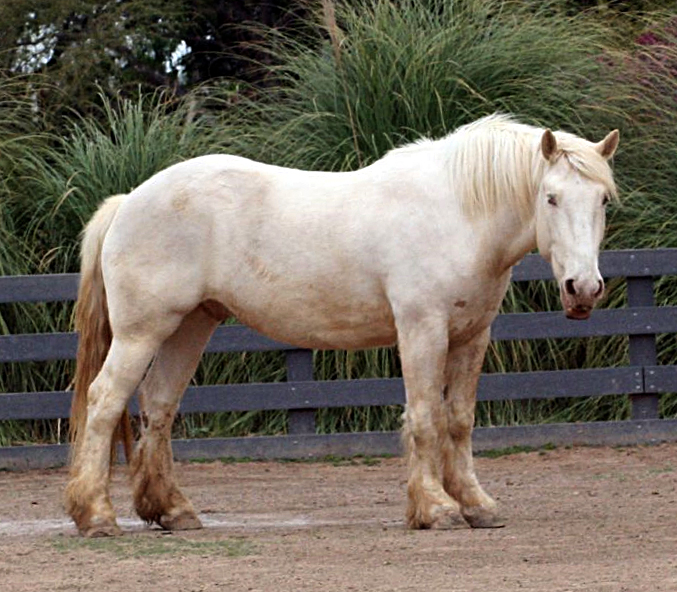 The breed has a refined head, with a profile that is neither concave or convex. They have a wide chest, sloping shoulders, and a short, strong back, deep throughout the heart girth, with well-sprung ribs, short-coupled with well-muscled hindquarters, good strong legs in proportion to body set wide apart with strong, sure feet and free and easy movement. The breed is reputed to have a calm, willing temperament, particularly suited for owners who are new to handling draft horses. Mares stand 15 to 16 hands (60 to 64 inches, 152 to 163 cm) high and weigh 1,500 to 1,600 pounds (680 to 730 kg), while stallions and geldings stand 16 to 16.3 hands (64 to 67 inches, 163 to 170 cm) and weigh 1,800 pounds (820 kg) or more.
The breed has a refined head, with a profile that is neither concave or convex. They have a wide chest, sloping shoulders, and a short, strong back, deep throughout the heart girth, with well-sprung ribs, short-coupled with well-muscled hindquarters, good strong legs in proportion to body set wide apart with strong, sure feet and free and easy movement. The breed is reputed to have a calm, willing temperament, particularly suited for owners who are new to handling draft horses. Mares stand 15 to 16 hands (60 to 64 inches, 152 to 163 cm) high and weigh 1,500 to 1,600 pounds (680 to 730 kg), while stallions and geldings stand 16 to 16.3 hands (64 to 67 inches, 163 to 170 cm) and weigh 1,800 pounds (820 kg) or more.
The ideal color for the breed is a medium cream with pink skin, amber eyes and a white mane and tail. The cream color of the breed is produced by the champagne gene (CH). Recognized colors include light, medium and dark cream, with amber or hazel eyes. A cream mare with dark skin and a light mane and tail can be accepted for "foundation stock," while stallions must have pink skin and white manes and tails to be registered. Purebred American Cream foals that are too dark are accepted into the main breed registry may be recorded into an appendix registry. The appendix will also accept half-cream horses crossed with other draft bloodlines if they meet certain requirements, and the registry provides an upgrade system that uses appendix horses to strengthen genes, increase breed numbers, and allow more diversified bloodlines. Dark-skinned American Cream Draft horses are actually chestnuts, as the breed is nothomozygous for the champagne gene, only one allele is needed to produce the proper color. Champagne dilutes any base coat color, and in the American Cream Draft, the underlying genetic base color is chestnut. Based on current knowledge, breed also does not carry the cream gene, even though breeders refer to the desired color as "cream". The American Cream Draft is never cremello or white and though the gold coat color with a white mane and tail resembles palomino, the breed's defining characteristics are the result of the champagne gene.
The autosomal recessive genetic disease Junctional epidermolysis bullosa (JEB), has been found in some American Cream Drafts. This is a lethal genetic disorder that causes newborn foals to lose large areas of skin and have other abnormalities, normally resulting in euthanasia. It is most commonly associated with Belgian horses, but is also found in other draft breeds. A DNA test was developed in 2002, and foals affected by JEB can be avoided as long as two carriers are not bred to one another. The American Cream registry states that it has "been pro-active in testing its registered animals since JEB was discovered".
